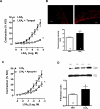Lipoxin A4 mediates aortic contraction via RHOA/RHO kinase, endothelial dysfunction and reactive oxygen species
- PMID: 25612650
- PMCID: PMC4323151
- DOI: 10.1159/000371490
Lipoxin A4 mediates aortic contraction via RHOA/RHO kinase, endothelial dysfunction and reactive oxygen species
Abstract
Background: Lipoxin A4 (LXA4) is a biologically active product generated from arachidonic acid by lipoxygenase action. The production of lipoxins is enhanced by aspirin through acetylation of cyclooxygenase-2, via a mechanism known as 'aspirin-triggered lipoxin'. LXA4 has both anti-inflammatory and proinflammatory actions, the latter being related with reocclusion and restenosis after coronary angioplasty in patients treated with aspirin. However, little is known of the actions of LXA4 on the vasculature. We hypothesized that LXA4 promotes contractile responses and contributes to endothelial dysfunction.
Methods: We used aorta from Wistar rats to assess vascular function. Reactive oxygen species (ROS) production and contractile and regulatory proteins were investigated.
Results: LXA4 induced concentration-dependent contractions via formyl peptide receptor-2 activation and both RhoA/Rho kinase inhibitor and ROS scavenger decreased this contraction. Also, endothelium removal, and COX-2 and NAD(P)H oxidase inhibitors attenuate the LXA4-induced contraction. LXA4 potentiated phenylephrine-induced contraction and inhibited acetylcholine-induced relaxation. In the presence of LXA4, ROS production was increased and protein expression of RhoA, phospho-myosin light chain, COX-2 and p67phox was higher.
Conclusion: LXA4 has a functional role in the vasculature and may contribute to further vascular damage in conditions where its production is exacerbated, such as in angioplasty-associated complications treated with aspirin.
© 2015 S. Karger AG, Basel.
Figures







References
Publication types
MeSH terms
Substances
Grants and funding
LinkOut - more resources
Full Text Sources
Other Literature Sources
Research Materials

